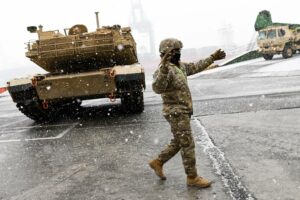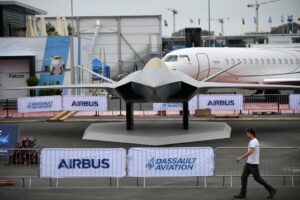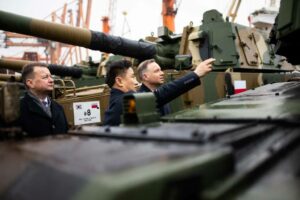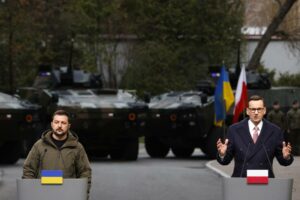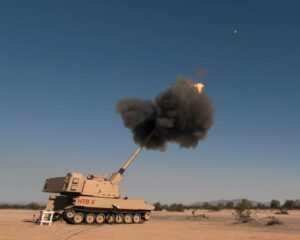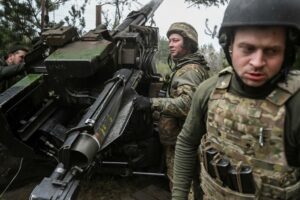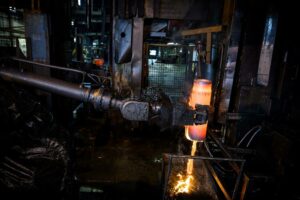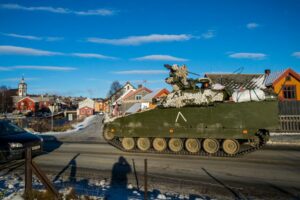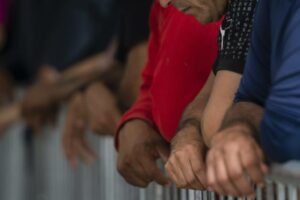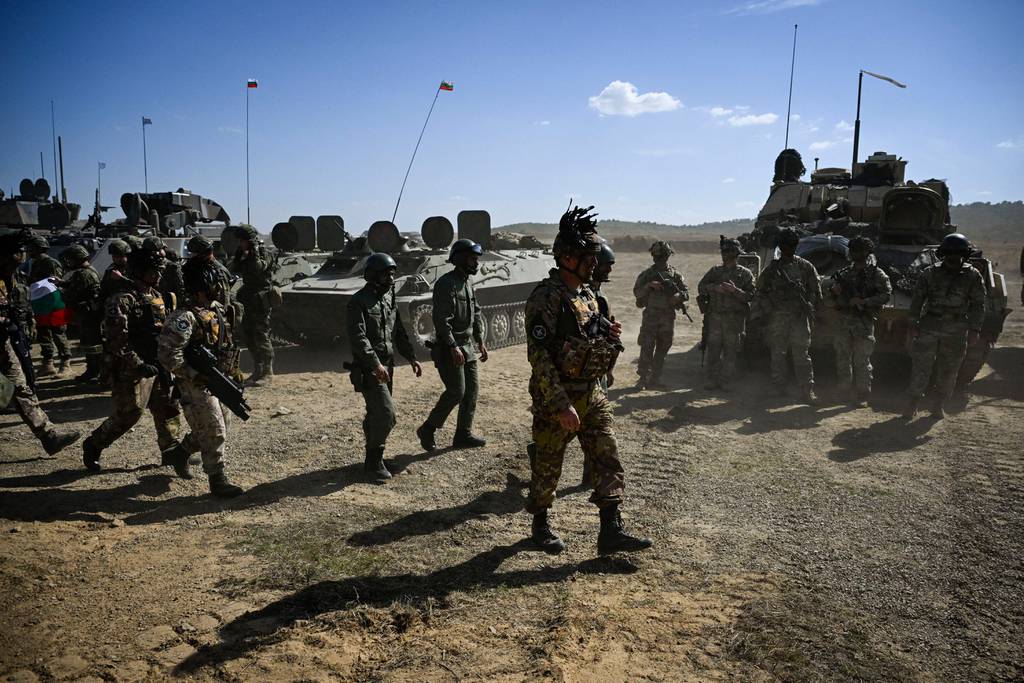
ROME — Italy will pick industrial partners to start work on a major new €5 billion ($5.4 billion) tracked fighting vehicle program within “a few months,” an Italian senior army official has told Defense News.
Companies will be invited to launch feasibility studies for the program which is expected to lead to a 1,000 vehicle purchase as Italy hurries to replace its aging Dardo vehicles, and as the war in Ukraine has put land combat back on the map.
Furthermore, with Italy determined to involve European firms, the program could prove a catalyst for industrial integration in the sector, as soon as Rome can decide on who to pick from potential partners like Italy’s Leonardo and Iveco, French-German team-up KNDS, and Germany’s Rheinmetall.
“From a programatic point of view, all documents related to the operational requirement have been approved and the Ministry of Defence has allocated an important part of the necessary budget,” said Maj. Gen. Francesco Olla, the head of the Italian army’s General Planning and Financial Division.
“Therefore, the procurement activities will begin in next few months,” he added.
Formerly called the Armored Infantry Combat System (AICS) and now renamed the Army Armored Combat System (A2CS), the program foresees a vehicle able to share targets with other platforms, use a wide range of ammunition, including airburst rounds, and capable of tackling threats from improvised explosive devices and anti-tank missiles as well as swarming drones.
The Italian army also envisages a vehicle with scalable armor, open architecture, hefty command and control capability and the ability to work with drones and unmanned ground vehicles.
Italy’s 2023 defense budget mapped out spending of €5.2 billion on the program over 14 years, projecting that final spending would rise to €15 billion.
The document also claimed the program would be run in a “multi-national context, based on alliances with solid European firms that already work with Italian companies.”
Olla said that was because no one European nation could now afford to develop its own vehicle.
“I do not see any EU country capable of developing such a complex technological program alone, because of the associated costs and requested technological know-how. Therefore, we expect to see multinational cooperation in this regard and I am sure that the recent agreement signed by Leonardo and KNDS is a very encouraging step toward that direction,” he said.
In December Italy’s state defense champion Leonardo and Franco-German consortium KNDS signed what the companies called a “strategic alliance.” The pact is meant to bring Italy on board the European battle tank program known as the Main Ground Combat System (MGCS) and guide talks on workshare on new Leopard tanks Italy is ordering from KNDS.
The deal also mentions a possible team-up on the A2CS program, said a source knowledgable of the deal who declined to be named because he was not authorized to speak to the media.
An KNDS spokesman said, “The Italian vehicle could be a program for possible cooperation between Italian industry and KNDS.”
KNDS may consider offering Italy the tracked version of its Boxer vehicle, which it has tested and showed off at the Eurosatory defense show in France in 2022 but not put into production.
Olla said he was wary of Italy buying an existing vehicle, adding he would like to see Italian industry take the role of design authority.
“It is not only a matter of investments and jobs obtained in our homeland, but also an operational problem, if you think of the logistics of the systems and the required development and upgrades they will bring with them.”
He added, “It does not mean that Italy will be self-sufficient, but we need to recover our industrial capabilities to produce high-quality platforms, which represent the best tool we can put in the hand of our warriors to give them the higher probability to accomplish their mission and get back home safe.”
Rheinmetall, which is offering Italy its tracked Lynx vehicle, said it is ready to hand over design authority.
“The Lynx is the most modern Infantry Fighting Vehicle available today. It has open architecture and because we control the product, we can give Italy technology transfer and the design authority,” said Alessandro Ercolani, the CEO of the firm’s Italian subsidiary, Rheinmetall Italia.
Ercolani said Italy would risk delaying the program if it tried to develop a vehicle from scratch.
“Italy would need 5-7 years to design a new IFV or tank, something it has not done since the 1990s, and there would be the cost of development to consider,” he said.
Asked if Rheinmetall was at a disadvantage in talks since Leonardo had already signed a strategic deal with KNDS, Ercolani replied: “We are not at a disadvantage because KNDS does not have an IFV to offer at this time.”
The need for more European cooperation on big-ticket programs has been stressed repeatedly by Leonardo CEO Roberto Cingolani, and A2CS could be a prime catalyst at a moment when the European main battle tank is mired in delay.
But if Italy wants a multi-national alliance to work on the A2CS program, officials in Rome may have to bring some patience while the pieces of that alliance fit together.
A source familiar with the program told Defense News that the nascent effort was parked with procurement officials who are waiting to see what industrial consortium might evolve to handle a feasibility study.
Leonardo, which is certain to be involved, not only signed its cooperation deal with KNDS in December, but also has a well established joint venture to build military vehicles with Italy’s Iveco, called CIO.
“One possibility would be for the work on the study to be handed to CIO, but officials are waiting for a signal from industry about evolving alliances that will want to handle the work,” said the source who declined to be named because he was not allowed to speak on the record.
Leonardo has reportedly mulled the purchase of Iveco Defence Vehicles – the branch of Iveco with which it runs CIO – in order to bulk up its land operations business ahead of potential European consolidation in the industry.
“Leonardo needs to decide what to do on that front,” said the source. Ultimately, he added, if Italy wants a new vehicle it will need to accept longer development times. “That is why this consortium needs to come together fast,” he added.
Tom Kington is the Italy correspondent for Defense News.
- SEO Powered Content & PR Distribution. Get Amplified Today.
- PlatoData.Network Vertical Generative Ai. Empower Yourself. Access Here.
- PlatoAiStream. Web3 Intelligence. Knowledge Amplified. Access Here.
- PlatoESG. Carbon, CleanTech, Energy, Environment, Solar, Waste Management. Access Here.
- PlatoHealth. Biotech and Clinical Trials Intelligence. Access Here.
- Source: https://www.defensenews.com/global/europe/2024/01/25/italy-tees-up-5-billion-plus-program-to-build-1000-combat-vehicles/
- :has
- :is
- :not
- $UP
- 000
- 1
- 14
- 2022
- 2023
- 70
- a
- ability
- Able
- About
- Accept
- accomplish
- activities
- added
- adding
- Aging
- Agreement
- ahead
- All
- Alliance
- Alliances
- allocated
- allowed
- alone
- already
- also
- am
- ammunition
- an
- and
- any
- approved
- architecture
- ARE
- Army
- AS
- associated
- At
- authority
- authorized
- available
- back
- based
- Battle
- BE
- because
- been
- begin
- BEST
- between
- Billion
- board
- Branch
- bring
- budget
- build
- business
- but
- Buying
- by
- called
- CAN
- capabilities
- capability
- capable
- Catalyst
- ceo
- certain
- champion
- CIO
- claimed
- combat
- come
- Companies
- complex
- Consider
- consolidation
- consortium
- context
- control
- cooperation
- Cost
- Costs
- could
- country
- deal
- December
- decide
- defence
- Defense
- delay
- delaying
- Design
- determined
- develop
- developing
- Development
- Devices
- direction
- Disadvantage
- Division
- do
- document
- documents
- does
- done
- Drones
- effort
- encouraging
- established
- EU
- European
- evolve
- evolving
- existing
- expect
- expected
- familiar
- FAST
- feasibility
- few
- fighting
- final
- financial
- firms
- fit
- For
- France
- from
- front
- Gen
- General
- get
- Give
- Ground
- guide
- had
- hand
- handle
- Have
- he
- head
- high-quality
- higher
- Home
- homeland
- HTTPS
- i
- if
- images
- important
- in
- Including
- industrial
- industry
- integration
- into
- Investments
- invited
- involve
- involved
- IT
- italia
- Italian
- Italy
- ITS
- Jobs
- joint
- joint venture
- jpg
- known
- Land
- launch
- lead
- like
- logistics
- longer
- lynx
- Main
- major
- map
- Matter
- May..
- mean
- meant
- Media
- mentions
- might
- Military
- ministry
- missiles
- Mission
- Modern
- moment
- months
- more
- most
- multi-national
- multinational
- Named
- nascent
- nation
- necessary
- Need
- needs
- New
- news
- next
- no
- now
- obtained
- of
- off
- offer
- offering
- official
- officials
- on
- ONE
- only
- open
- operational
- Operations
- or
- order
- Other
- our
- out
- over
- own
- part
- partners
- Patience
- pick
- pieces
- planning
- Platforms
- plato
- Plato Data Intelligence
- PlatoData
- Point
- Point of View
- possibility
- possible
- potential
- Prime
- probability
- Problem
- procurement
- produce
- Product
- Production
- Program
- Programs
- Prove
- purchase
- put
- range
- ready
- recent
- record
- Recover
- regard
- related
- REPEATEDLY
- replace
- reportedly
- represent
- requested
- required
- requirement
- Rise
- Risk
- Role
- rome
- rounds
- Run
- runs
- safe
- Said
- scalable
- scratch
- sector
- see
- senior
- Share
- show
- showed
- Signal
- signed
- since
- solid
- some
- something
- Soon
- Source
- speak
- Spending
- start
- State
- Step
- Strategic
- studies
- Study
- subsidiary
- such
- sure
- system
- Systems
- tackling
- Take
- Talks
- tank
- Tanks
- targets
- technological
- Technology
- tested
- that
- The
- The Source
- their
- Them
- There.
- therefore
- they
- think
- this
- threats
- time
- times
- to
- today
- together
- told
- tool
- toward
- transfer
- tried
- Ukraine
- Ultimately
- upgrades
- use
- vehicle
- Vehicles
- venture
- version
- very
- View
- Waiting
- want
- wants
- war
- War in Ukraine
- Warriors
- was
- we
- WELL
- What
- when
- which
- while
- WHO
- why
- wide
- Wide range
- will
- with
- within
- Work
- would
- years
- you
- zephyrnet

